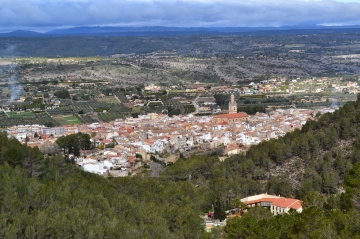 30,67 Ha.
30,67 Ha.
 484 m2
484 m2
 5
5
 5
5
 Good condition
Good condition
 3000356
3000356
 Enguera
Enguera
 30,67 Ha.
30,67 Ha.
 484 m2
484 m2
 5
5
 5
5

The town of Enguera, with 5,083 inhabitants, is located in the southwest of the province of Valencia, at an altitude of 318 metres. Located in the foothills of the mountain range to which it gives its name with an extensive municipal area of 240.25 km2.
Its territory is integrated in the region of La Canal de Navarrés, geographically in the Massif of Caroche, forming a mountainous transition area between the Iberian and Penibetic systems.
It is one of the most attractive areas of the Valencian Community. Come, meet its people and their customs. In Enguera, everything - nature, history, culture and tradition - has been built on the ruggedness of the mountain range, the fertile plain of its valley, its clean houses and its white village.
First archaeological remains: Prehistory and Iberian Culture.
The existence of archaeological vestiges and, above all, the appearance of some atypical flint in the Llano de Jesús are the elements that indicate the oldest occupation of the district of Enguera by human groups since the Mesolithic (8000-5000 BC).
From the late Eneolithic, or perhaps the beginning of the Bronze Age (1600 BC) are the objects and human remains found in the Cueva de la Carrasquilla and in sites such as Castillarejo and Peña del Tossal.
In the Iberian period, in Cerro Lucena, an oppidum was built which was inhabited between the 4th and 3rd centuries BC. Its excavation provided invaluable information for the knowledge of this culture. Part of the objects from its excavation can be seen in the Municipal Archaeological Museum of Enguera.
The Romanization
From the time of the Roman Emperor Augustus (1st century BC), the population was dispersed over the flatter lands of the municipality, as evidenced by the remains of Roman villas found in Faracuat and Alto de Vistabella.
The Islamic Invasion
During the period of Islamic domination, the town had a moment of ephemeral splendour in the 12th century AD, when, by virtue of one of the administrative divisions produced in the Taifas kingdoms, it was converted into the head of an Iqlim, as the castle of Enguera occupied a key position within the strategic-military device of the area. Furthermore, it should be emphasized that important vestiges of this period remain, both archaeological (the castle from the Almoravid period) and toponyms that have been reflected in some of the districts and hamlets within the municipality (Albalat, Benamil, Benacancil, Benali, Benamil, etc).
The transition from Islamic to Christian domination was carried out by the Treaty of Almizra (26 March 1244), which led to the incorporation of the town into the Crown of Aragon whose king, Jaime I, ceded it to the Military Order of Santiago de Uclés, which, in spite of having its headquarters in Castile, initially repopulated Enguera with Aragonese and expelled the Muslims who did not want to be subjugated.
The Order of Santiago
For three and a half centuries, the order of Santiago maintained the lordship over the town until Philip II in 1569, harassed by the debts caused by the wars in Europe, obtained from Pope Pius V the authorization to sell it with all its vassals, which materialized on December 17, 1575 when it was bought by Bernabé de Borja, a member of the most important family of the Valencian Renaissance.
The most relevant event of the 18th century was the earthquake of 1748, which instead of being a paralysing element in the life of the municipality, made it possible, after obtaining significant financial aid from King Fernando VI to alleviate the damage, to start a major economic boom based on the wool manufacturing industries, which remained the main source of wealth during the 19th and most of the 20th centuries.



